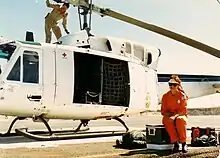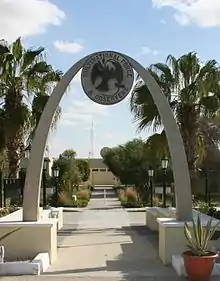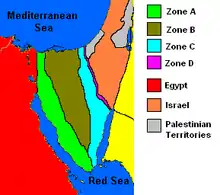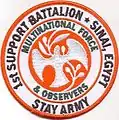| Multinational Joint Task Force | |
|---|---|
 MFO insignia | |
| Founded | August 3, 1981 |
| Countries | See Contributing states |
| Allegiance | US-Egyptian-Israeli-backed peacekeeping force |
| Type | Multinational force |
| Role | Combined operations |
| Nickname(s) | MFO |
| Website | http://mfo.org/en |
| Commanders | |
| Current commander | Major General Pavel Kolář (CZ)[1] |
| Insignia | |
| Flag |  |
The Multinational Force and Observers (MFO) is an international peacekeeping force overseeing the terms of the peace treaty between Egypt and Israel. The MFO generally operates in and around the Sinai peninsula, ensuring free navigation through the Straits of Tiran and the Gulf of Aqaba, and compliance with the other terms of the Egypt–Israel peace treaty.
Background











On September 17, 1978, the Camp David Accords were signed by Israeli Prime Minister Menachem Begin and Egyptian President Anwar Sadat under the sponsorship of United States President Jimmy Carter. The accords provided for a full Israeli withdrawal from Sinai.
Following the signing of the Egypt–Israel peace treaty on March 26, 1979, the United Nations was asked to provide the peacekeeping forces for the Sinai Peninsula mandated in the treaty. The terms of the treaty required the presence of international peacekeepers to ensure that both Israel and Egypt kept to the provisions regarding military build-up along the border.[2]
Initially, the peacekeeping force was provided by the U.S. Sinai Field Mission, while efforts were made to create a UN force.
On May 18, 1981, the President of the UN Security Council indicated that the UN would be unable to provide the force, due to the threat of a veto of the motion by the USSR at the request of Syria.[3]
As a result of the UN Security Council impasse, Egypt, Israel and the United States opened negotiations to set up a peacekeeping organization outside the framework of the UN. On August 3, 1981, the Protocol to the Treaty of Peace was signed, establishing the Multinational Force and Observers.[2]
From 2012 to 2016, the MFO's North Camp was under threat from Islamic State of Iraq and the Levant – Sinai Province attacks and also "experienced periods of water and fuel shortages, and a near-total cut-off of internet access and mobile and landline phones during persistent Egyptian military operations."[4] By September 2016, the MFO's northern camp was reorganized, with duties not related to observer responsibilities allocated to the south.[4] 75 US soldiers were deployed with new communications equipment to bolster the MFO's manpower.[5] The camps are reinforced with smart fences, more surveillance cameras and optics.
Mission
The mission of the MFO is:
"... to supervise the implementation of the security provisions of the Egyptian–Israeli Treaty of Peace and employ best efforts to prevent any violation of its terms."[6]
This is accomplished by carrying out four tasks:
- Operating checkpoints and observation posts and conducting reconnaissance patrols of the international border and Zone C,
- Verifying not less than twice a month that the terms of the peace treaty are being implemented,
- Verifying peace treaty compliance within 48 hours of a request by either party,
- Ensuring freedom of international marine navigation in the Strait of Tiran and access to the Gulf of Aqaba
Over the four decades that the MFO has carried out its mission, it has proven a highly successful force. The desire for peace on the part of both Egypt and Israel, combined with the effectiveness of the MFO, has resulted in a durable and lasting state of peace between these two nations.[7]
Organization
The MFO has its main headquarters in Rome, where it is headed by the Director-General. It also has two regional offices, in Tel Aviv and Cairo, while the Force itself is based in Zone C on the Sinai Peninsula, under the command of the Force Commander.
The Force Commander is responsible for the military elements of the MFO, which comprise:[8]
- Headquarters
- Three infantry battalions (FIJIBATT, COLBATT and USBATT)
- 1st US Support Battalion (Formerly the Logistical Support Unit)
- Coastal Patrol Unit (CPU)
- Rotary Wing Aviation Unit (AVCO)
- Fixed Wing Aviation Unit (FWAU)
- Transport and Engineering Unit (TREU)
- Military Police Unit (FMPU)
- Flight Following (Air Traffic control) Unit
The Observer contingent of the MFO is made up entirely of US civilians.[9] The observers are either seconded from the US State Department or retired US military personnel.
Contributing states
As of December 2022, 13 states are contributing troops.
| State | Strength[10] |
|---|---|
| 27 | |
| 52 | |
| 275 | |
| 18 | |
| 170 | |
| 1 | |
| 78 | |
| 2 | |
| 30 | |
| 3 | |
| 2 | |
| 452 | |
| 41 | |
| Total troops: | 1,151 |
Chronology
- April 1983
Colonel Sitiveni Rabuka was appointed as Commanding Officer of the Fijian MFO contingent. After serving a two-year posting in the Sinai Colonel Rabuka returned to Fiji in 1985 to plan and stage a bloodless military coup which toppled the elected Fijian government on 14 May 1987.[11]
- February 1984
MFO Director-General Leamon Hunt was assassinated in Rome, Italy, while sitting in his chauffeur-driven armored car, outside the gates of his private residence. The assassins poured automatic weapon fire into the reinforced rear window until they were able to penetrate the glass and strike the director-general in the head. Responsibility for the assassination was claimed by Lebanese Armed Revolutionary Faction the Red Brigade.[12]
- March 1985
Due to the imminent end of the four-year Australian MFO commitment in April 1986, the governments of Israel, Egypt, and the United States invited Canada to provide a contingent. Canada agreed to replace Australia in the MFO and to supply a helicopter squadron, staff officers and a flight-following section of air traffic controllers totalling 136 military personnel. The Canadian Contingent (CCMFO) was brought on strength of the Canadian Forces on September 26, 1985.[13]
- December 1985
On December 12, 1985, a chartered Arrow Air DC-8 with 248 returning members of the U.S. 101st Airborne Division and eight flight crew crashed into the cold, damp landscape at the end of runway 22 at Gander International Airport in Gander, Newfoundland, with no survivors. The 101st was rotating home from a tour of duty with the MFO. The accepted theory is that the crash was caused by ice accumulation on the leading surfaces of the wings, but debate and speculation still rages that the crash may have resulted from some type of incendiary device placed on the plane.[14]
- April 1986
The Australian contingent, consisting of staff officers and a helicopter squadron who were members of the initial deployment, withdrew in the course of their government's reduction of its peacekeeping commitments. They were replaced by the CCMFO Canadian Rotary Wing Aviation Unit, equipped with nine CH135 Twin Hueys, staff officers and flight following. The CCMFO was operational at El Gorah on March 31, 1986. Canadian tactical helicopter units rotated to El Gorah for six-month tours of duty. The primary units providing military personnel were 408, 427 and 430 Tactical Helicopter Squadrons and 403 Squadron Helicopter Operational Training Squadron.[15]
- January 1993
The Australians, who had been replaced by a British contingent, returned to the mission, and the British contingent withdrew.[16] Lieutenant Colonel Martin Hamilton-Smith was the first contingent commander of the returning Australians. He went on to become a South Australian politician after his military career.[17]
- August 1994
Australian MFO contingent members were involved in a hit-and-run accident that they failed to report. The incident[18][19][20][21][22][23] came to light when one of the vehicle passengers, army Staff Sergeant David Hartshorn, reported it after he had been returned to Australia. Prima facie evidence of the incident was established and included in a formal inquiry by the Australian government in 2004.[24] In an article by News Limited Network journalist Ian McPhedran on 30 August 2012, former Staff Sergeant David Hartshorn has received an apology from former Australian Army Chief Lieutenant General David Morrison and Inspector General of the Australian Defence Force Mr Geoff Earley for being ordered not to report the hit and run accident.[25]
- January 2002
The 2nd Battalion, 153rd Infantry Regiment of the Arkansas National Guard become the first National Guard unit to deploy to Task Force Sinai as part of Operation Noble Eagle. They relieved the 2-87th Infantry of the 10th Mountain Division based at Fort Drum, NY.[26]
- May 2007
A French Air Force de Havilland Canada DHC-6 Twin Otter aircraft on duty with the MFO Fixed Wing Aviation Unit crashed in the middle of the peninsula, 80 kilometres (50 mi) south of the town of Nakhl. All passengers and crew were serving members of the MFO, eight French and one Canadian, and all were killed. The aircraft reported trouble with one engine and was attempting an emergency landing on a highway when it struck a truck. It crashed and exploded moments later. The driver of the truck escaped unharmed.[27]
- September 2012
Dozens of armed militants attacked North Camp on Friday 14 September 2012, breaking down a wall of the facility housing the MFO headquarters, setting fire to vehicles and facilities. MFO soldiers defended the base and there was an exchange of fire. Four MFO members were reportedly wounded.[28][29][30]
- October 2013
Parts of the MFO view cutbacks of the military aid from United States to Egypt as negative for the stability in Sinai, as the military government had hit militants hard.[31]
- March 2014
MFO held a swearing-in ceremony to welcome the new Force Commander of MFO, Major-General Denis Thompson of Canada, formerly the Commander of CANSOFCOM.[32]
- March 2015
The Canadian contingent added 30 Canadian military police officers as part of the MFO Military Police Unit. This commitment lasted four years, until March 2019.[33]
- April 2015
The Hungarian contingent withdrew from the Sinai, wrapping up their 20-year mission.[34]
- March 2017
Australian Major General Simon Stuart assumes command of the MFO, replacing Major-General Denis Thompson from Canada.[35]
- February 2019
A visit was made to the MFO by Kentaro Sonoura, Special Advisor to Japanese Prime Minister Abe, as part of considering contributing JSDF personnel to the MFO.[36]
- March 2019
The Canadian contingent completed four years of support with the Military Police Unit, including commending that unit. The Canadian commitment switched to providing 55 Canadian Forces personnel as senior advisors, headquarters staff, as well as experts in remote observation, logistics support, military engineering, policing and training.[33]
- April 2019
The JSDF has dispatched personnel to the MFO.[37][38]
- November 2020
Seven MFO members (five U.S., one Czech, and one French) died in an MFO UH-60 Black Hawk helicopter crash near Sharm El Sheikh. An American peacekeeper was wounded in the crash and evacuated by Israeli search and rescue soldiers from Air Force Unit 669 to Soroka Medical Center in Beersheba, Israel.[39][40]
Sinai peacekeeping zones

Article 2 of Annex I of the Peace Treaty called for the Sinai Peninsula to be divided into zones. Within these zones, Egypt and Israel were permitted varying degrees of military buildup:
- Zone A: Between the Suez Canal and Line A. Egypt is permitted a mechanized infantry division with a total of 22,000 troops in Zone A.
- Zone B: Between Line A and Line B. Egypt is permitted four border security battalions to support the civilian police in Zone B.
- Zone C: Between Line B and the Egypt–Israel border. Only the MFO and the Egyptian civilian police are permitted within Zone C.
- Zone D: Between the Egypt–Israel border and Line D. Israel is permitted four infantry battalions in Zone D.
Within Zone C there are two main installations:
- North Camp is at El Gorah, 37 km southeast of El Arish and is the location of the military Force HQ.
- South Camp is located between the towns of Sharm El Sheikh and Naama Bay.
In addition there are thirty smaller sites at various points within Zone C. One remote observation post (OP 3-11) is located offshore on Tiran Island, requiring resupply by air or sea.
Zone C
Zone C is subdivided into sectors, each controlled by a Sector Control Center. The sectors are numbered from north to south, with an infantry battalion assigned to a pair of consecutively numbered sectors:
- Sectors 1 and 2 – FijiBatt
- Sectors 3 and 4 – ColBatt
- Sectors 5 and 7 – USBatt (The 3 original sectors were reorganized into 2 sectors)[41]
Badges
 Badge worn by members of the Canadian Contingent Rotary Wing Aviation Unit 1989–90
Badge worn by members of the Canadian Contingent Rotary Wing Aviation Unit 1989–90 Souvenir patch for members of the 1st Support Battalion.
Souvenir patch for members of the 1st Support Battalion.
Life in the Sinai
Maintaining a good quality of life for MFO members in the Sinai is difficult, due to the remoteness and desolation of the region as well as more recent security concerns. Gym facilities, clubs, medical facilities, libraries and exchanges are provided at both North Camp and South Camp.[42] In addition, North Camp possesses a pool while South Camp boasts Herb's Beach, a section of the Red Sea coastline where it is possible to snorkel just a few feet into the water and see a variety of tropical fish.
The Force has its own magazine, the bimonthly and bilingual Sandpaper. Published in English and Spanish it is produced by the Press and Visits Office.[43] Sporting events are held at both camps. Members are encouraged to take visits to Israel and Egypt, usually in organized trips. There are also trips to Mount Sinai, Luxor, Cairo, Jerusalem, and other sites within Egypt and Israel. A television and radio system also service North Camp and South Camp.[42]
There are venues for live shows at both camps and the U.S. organization Armed Forces Entertainment provides a variety of bands, dancers and other acts to keep the troops entertained.
At remote observation sites, which might house only a dozen peacekeepers, the quality of life is harder to maintain. During tours at remote sites peacekeepers have limited access to the internet, are provided with workout equipment, and are permitted mascots. Pets are not allowed at the main camps, even though a veterinarian is available to maintain the health of the animals, which are almost always dogs.
After the original inception of the MFO, routine travel to al-Arish, Sharm El Sheikh and a beach facility near the Gaza Strip were restful getaways but recent security concerns over possible Hamas activity has changed that. Similarly, a bicycle competition known as the Tour de Sinai which had begun in 1985 had gone by the wayside in recent years.[44]
See also
- United Nations Emergency Force – the United Nations peacekeeping operation stationed in the Sinai after the Suez Crisis of 1956 to maintain the truce between Egypt and Israel
References
- ↑ "MFO Welcomes a New Force Commander". MFO.org. Retrieved March 5, 2023.
- 1 2 10 Tactical Air Group: Canadian Contingent Multinational Force and Observers Handbook (unclassified), page A-1. DND, Ottawa, 1986.
- ↑ Hoagl, Jim (May 24, 1979). "U.N. Peacekeeping Unit Won't Police Israeli Sinai Withdrawal". The Washington Post.
- 1 2 Gold, Zack (April 13, 2016). "Rebalancing International Forces to Safely Carry out Their Mission in Egypt's Sinai". Atlantic Council.
- ↑ Hennigan, W. J. (April 23, 2016). "U.S. shifts troops in the Sinai Peninsula after attacks by militants". Los Angeles Times. Retrieved September 19, 2018.
- ↑ "MFO - Multinational Force and Observers". August 16, 2006. Archived from the original on August 16, 2006. Retrieved September 19, 2018.
- ↑ Canadian Contingent Multinational Force and Observers Handbook, 10 Tactical Air Group, July 1987 (unclassified) pg D-1
- ↑ "History - Op Mazurka - ARMY". Archived from the original on July 10, 2009.
- ↑ "GAO-04-883, Peacekeeping: Multinational Force and Observers Maintaining Accountability, but State Department Oversight Could be Improved".
- ↑ "Contingents". MFO. Retrieved December 24, 2022.
- ↑ Appelbaum, Diana Muir (August 27, 2012). "How the Sinai Peacekeeping Force Staged a Military Coup in Fiji". Jewish Ideas Daily. Archived from the original on January 10, 2016. Retrieved January 22, 2016.
- ↑ Associated Press (February 16, 1984). "Red Brigade claims assassination of Hunt". Kentucky New Era. p. 5A. Retrieved May 1, 2013.
- ↑ Canadian Contingent Multinational Force and Observers Handbook, 10 Tactical Air Group, July 1987 (unclassified) pg 1
- ↑ "Congressional Record". fas.org. July 20, 1989. Archived from the original on March 6, 2000. Retrieved December 30, 2022.
- ↑ Canadian Contingent Multinational Force and Observers Handbook, 10 Tactical Air Group, July 1987 (unclassified) pg 1 and A-4
- ↑ "Australian Commonwealth of Australia Gazette S27 establishing Operation Mazurka Australia's contribution to MFO Sinai" (PDF). Archived from the original (PDF) on April 24, 2013.
- ↑ "Profile: Hon Martin Hamilton-Smith". Archived from the original on January 16, 2016. Retrieved January 22, 2016.
- ↑ "Submissions received by the committee as at 21/02/05". Archived from the original on January 28, 2016. Retrieved January 22, 2016.
- ↑ McPhedran, Ian (April 13, 2011). "Fighting a culture of cover-ups". Adelaide Now. Archived from the original on July 31, 2012.
- ↑ "Cover up forced soldier to quit". Chronicle. Archived from the original on March 18, 2012. Retrieved January 22, 2016.
- ↑ Dodd, Mark (March 9, 2012). "Haunting silence over fatal hit-and-run". The Australian. Archived from the original on April 20, 2012. Retrieved January 22, 2016.
- ↑ Davies, Adam (March 12, 2012). "Whistleblower waits for apology". Chronicle. Archived from the original on March 13, 2012. Retrieved January 22, 2016.
- ↑ Cumming, Stuart (September 25, 2013). "Cairo hit-and-run inspires dedicated paramedic". Chronicle. Archived from the original on January 30, 2016. Retrieved January 22, 2016.
- ↑ "ParlInfo - FOREIGN AFFAIRS, DEFENCE AND TRADE REFERENCES COMMITTEE : 22/04/2004 : Effectiveness of Australia's military justice system". Archived from the original on January 10, 2016. Retrieved January 22, 2016.
- ↑ McPhedran, Ian (August 30, 2012). "Army sorry over the cover-up of a hit-and-run in which the victim was 'only an Arab'". News.com.au. Archived from the original on February 6, 2016. Retrieved January 22, 2016.
- ↑ "2-153rd Infantry Battalion "Gunslinger"". Global Security.Org. Archived from the original on September 4, 2009. Retrieved January 12, 2010.
- ↑ "Quebecer among peacekeepers killed in Sinai plane crash". CBC News. May 2007. Archived from the original on June 23, 2008. Retrieved July 28, 2008.
- ↑ "Gunmen attack Sinai HQ of MFO peacekeeping force, four injured". The Times of Israel. Archived from the original on January 29, 2016. Retrieved January 22, 2016.
- ↑ Schenker, David (May 24, 2013). "Chaos in the Sinai: Will International Peacekeepers Be the Next Casualty?". The Washington Institute. Retrieved June 4, 2023.
- ↑ "Aust to provide $1.5m for Sinai mission". The Sydney Morning Herald. April 10, 2013. Archived from the original on April 12, 2013. Retrieved January 22, 2016.
- ↑ "'Israel bluntly told the US not to cut aid to Egypt'". Times of Israel. Retrieved June 4, 2023.
- ↑ "Canadian Denis Thompson leads Sinai peacekeeping force". CBC News. March 4, 2014. Archived from the original on September 24, 2015. Retrieved March 4, 2014.
- 1 2 Pugliese, David (April 25, 2019). "Canada renews military commitment to Multinational Force and Observers in the Sinai". Ottawa Citizen. Retrieved April 26, 2019.
- ↑ "Hungary peace-keepers wind up 20-year mission in Sinai". April 2, 2015.
- ↑ "Major-General Denis Thompson ends tour as MFO Force Commander in Sinai". March 2017.
- ↑ "MFO - the Multinational Force & Observers". mfo.org. Retrieved February 12, 2019.
- ↑ "Chief of Staff Commendation Award presented to Major General Simon Stuart".
- ↑ "Revision of the Implementation Plan for the International Peace Cooperation Assignments in Sinai Peninsula".
- ↑ Kershner, Isabel; Schmitt, Eric (November 12, 2020). "Helicopter Crash Kills 7 Peacekeepers From Multinational Force in Sinai". The New York Times. ISSN 0362-4331. Archived from the original on November 4, 2022. Retrieved November 13, 2020.
- ↑ Federman, Josef (November 14, 2020). "5 US soldiers among 7 peacekeepers killed in Sinai helicopter crash". Military Times. Archived from the original on November 13, 2020. Retrieved November 13, 2020.
- ↑ Canadian Contingent Multinational Force and Observers Handbook, 10 Tactical Air Group, July 1987 (unclassified) A-4 and A-5
- 1 2 Servants of Peace, Office of Personnel and Publications, Multinational Force and Observers, June 1999, Rome. Page 25
- ↑ Sandpaper, Apollo Publishing, Cairo, Sept/Oct/Nov 2007. Page 3
- ↑ Sandpaper, Apollo Publishing, Cairo, Special Edition, June 2007. Page 20